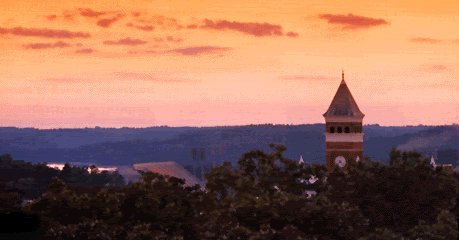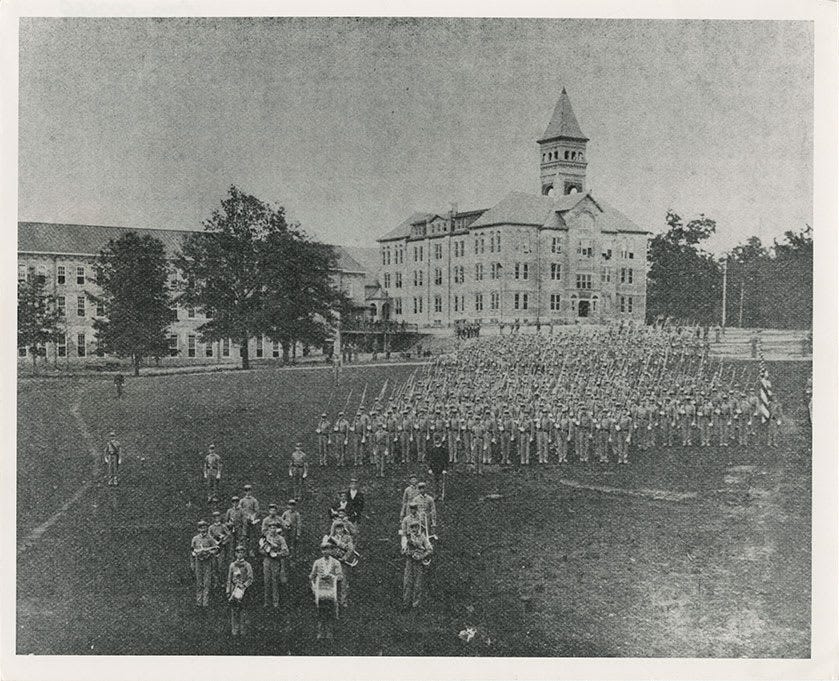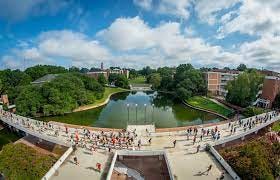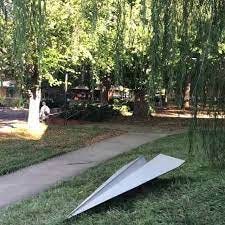Something in These Hills
something that makes a man or a woman stand taller, feel better and say with a high pride to all within earshot, “I went to Clemson.”
I find myself sitting on campus during the first week of classes. I’m starting a policy studies doctorate program this year, to go along with the applied economics masters I just completed in May. During the summer, I was able to work around campus doing various odd jobs and get a little bit more research experience, which I’m told is valuable. This relative downtime - compared to the hustle and bustle of finishing a thesis - provided me the much-needed opportunity to reflect on my two years here. I’m going to do the complaining first, and then we can get to the really sappy make-you-want-to-cry stuff. For my non-Clemson readers, if you click none of the other links, you must click the last one and read.
As somebody who grew up washed in the blood of Howard’s Rock and Clemson Bleu Cheese, I always knew I would find my way to Clemson. I was singing the alma mater at 3 and knew a lot more of the history and lore of the university than anybody should have. Obviously, I made a decision to choose a different path and attend the Naval Academy instead. I ended up committing 10 years to Annapolis and the Fleet, but always had a longing to make my way back to the foothills when the time came.
Even during those years away from Clemson, my perception of the university changed.
As a kid, it was easy to take pride in Clemson. With a top-notch engineering program and strong agricultural commitments, the small land-grant school in the upstate regularly found itself as a top-20 public university. Of course, a 12 year old doesn’t really grasp what it means to make those rankings, but it was a point of ignorant pride all the same. During those years, a few people from Marion always made it to Clemson to pursue further studies and it was always the coolest to see that happen. I think there was one from the class of 2008, none from 2009, and one from 2010. Nobody from my class went. The sakerlina gamecocks were having a miniature football renaissance in those years and gained a lot of popularity (despite a still empty trophy case). That, combined with cheaper tuition and slightly more lenient academic standards made it a more appealing destination.
That gamecock renaissance I mentioned did have one positive effect. I still needed to pick on my coot friends and I couldn’t do it through football, despite Navy giving them the business in 2011. To this day, I can’t understand why I got the trash talk after their 3-point win. Alas. Instead of the usual Clemson-sakerlina little brother trash talk, I decided to focus on prestige. Now, Clemson is by no means “prestigious”, but on all meaningful fronts, they’re strides ahead of those other guys. This would be my source of pride during my college years and beyond.
After college and during my time in the fleet, I matured and began to understand more and more the value of academic prowess. Eventually, the time came to think about grad school and the choice wasn’t so easy as I would have once thought. I’d taken an interest in a few different areas of study, but settled on an economics/policy focus. Despite flirting with George Washington University in DC, I ended up deciding Clemson was the way to go. They boasted the state’s only public policy program and, despite my lack of a masters degree, an applied economics program that would establish my research basis and propel me into the policy realm.
Clash of Cultures
When I got on campus in the fall of 2021, I quickly found that things weren’t quite as serious as they had been during my undergraduate studies, naturally. I expected some of the things I found. Gym clothes as everyday attire, for example. Obviously most college kids are not very serious people. Ideally, that’s what part of what college is for.
However, there were some underlying trends that it took me a while to notice that gave me pause. I could sense them in the peripheries of my purview, but it took some time to recognize patterns and diagnose some of my concerns.
After the first semester, I started making more detailed observations. I knew that Clemson’s football surge had increased out-of-state interest, but was shocked to find that 48% of the students entering in 2022 were out-of-state. There was an obvious neglect of the cornerstone college, the college of agriculture, in both funding and promotion. This was compounded by the fact that a large majority of ag students were in-state. The cornerstone college, boasting the largest percentage of in-state students, was easily the lowest prioritized. I’m not sure that Ben Tillman or Thomas Clemson would be thrilled about that.
I always heard that universities were run like businesses. The little ole Clemson from mama’s stories didn’t exist anymore. Still, even with tempered expectations, it was a shock to see it first hand. Many of the regular operations at the university were focused on revenue and the outward perceptions of Clemson. To some extent, at the expense of cornerstone programs and on-campus student maturation and involvement.
In a way, I suppose some of the university’s direction works in tandem with the collegiate experience as a whole. When I was growing up and even up til my college years, the college kids lived in dumpy apartments, if not on campus. Now, campus is only for freshmen and the off-campus housing leans more and more heavily towards “luxury” accommodations. The entire environment feels more corporate - more plastic and superficial - than a homey, cozy, sleepy college town.
It may come as a shock to you, dear reader, to find that the young man walking around in a Philadelphia 76ers tank top, with grimy white tennis shoes and a flat-bill hat isn’t all that interested in studying agriculture. Neither is the sorority girl from Connecticut that drives her parent-provided Mercedes, adorned with her greek letters on the back window. I would love to do a deep-dive on the program by program demographics, but shooting from the hip, these students are more interested in business, marketing, communications, etc. All fine programs, I’m sure. However, as the out-of-state population increases and these programs grow and demand more funding and resources, it comes at the expense of in-state students and the land-grant programs.
Land Grant Peril
While I did not consider it at the time, the lack of interest/feasibility in Clemson for in-state students certainly has a concerning angle. The university and state’s return on investment for in-state students is undeniably greater. A student from small town South Carolina is more likely to study in a program that benefits the state, is more likely to give back to the university, and is more likely to influence on-campus functions and, later, their communities in a way that benefit the university and the state. The squeaky wheel gets the grease and I don’t think the interlopers from New Jersey are asking many questions about funding and programs in the forestry department.
These concerns came to a head when Clemson released their new strategic plan in the spring of 2023. In it, they listed 3 priorities; Student Experience, Research Output, and Land Grant functions. In one man’s humble opinion, they got those exactly in the wrong order. I can only hope that Clemson adjusts course somewhat to emphasize the Land Grant Mission, instead of selling itself out for more business-oriented goals. Honestly, I believe that every single student in South Carolina should have an opportunity to study in a land grant program before any out of state students are admitted to study anything. For every Massachusetts-born landrover-driving sorority girl, there’s a kid from SC unable to get a seat. Follow the money.
The Naval Academy had a way to address these kinds of issues. I think it was 50% of each class had to study some form of engineering/STEM. This ensured that the resources being applied to the development of the officers corps were being invested in a way that benefitted the fleet the most. It doesn’t take a rocket scientist to figure out a way for a land-grant institution to implement a similar policy. If that sounds unreasonable, I think you’re missing out on the importance of a land grant institution. Read this for a little context.
Something in These Hills
It certainly has not been all doom and gloom. I made a point to be as involved as possible in on-campus events such. I’ve been to the First Friday parade (started by the writer’s mother & co. in 1974, the dark days of Clemson football wandering the desert like the Israelites). I took every flyer that was offered to me on library bridge. I found each of the 6 Friday Fliers. I wore my orange every Friday and reveled in each tune played on the carillon bells of Tillman Hall. I soaked up every bit of the magic as I could, recognizing that it would’ve been one hell of a place to spend those 4 years as a kid. Within that, I learned that Clemson, for me, couldn’t be what it was for my mother. I could never see it through the lens of an 18-year-old kid leaving home for the first time.
That’ll always be something I think about, but I also learned that Clemson could mean something unique to me.
Adjusting to this new phase of life after the navy was easily the most challenging part of my 2 years. Trying to get over the SWO-guilt of not showing up somewhere ten minutes early. Eating a few too many chicken tenders at the Esso Club. Learning to only say about 50% of the mean things to somebody that you want to say. They always say that transition is a challenge, and it certainly was. Not in any conventional way, but finding the new path is trickier than I thought it would be.
I found myself in a great program. Despite not taking any economics courses in my undergraduate studies, I lucked into a course of study that spoke to my worldview without even knowing it. I made jokes with all of my friends about doing analytics with vegetables and how we were going to help the corn producers of Nebraska win the AL West. I learned about the Clemson Extension service, which I’d only heard of in passing before.
Now, more than ever, it seems to be a viable career path for public service, research, and natural resources.
After getting over the “oh shit” of my first few weeks in graduate level econ courses, I settled in and put my academic work on cruise control. I got the work done, but never had a montage experience of slaving away to a eureka! moment. I knew I was on the right track when Dr. Scott Templeton, a professor in microeconomics for public policy, told me that he was proud of the progress I’d made from the first day to the last.
I think he was concerned in my lack of experience, even making a comment (without knowing my background) that our work was a little beyond something that a political scientist or an engineer might do.
Mostly, I spent lots of hours in a windowless dungeon in McAdams Hall, putting together a coherent thesis. I know a lot more about regional food markets, kale, sustainably sourced seafood, and water systems management than I ever would’ve cared to know. And I’m better for it.
I made sure to take a spare brick from McAdams to live as a doorstop on my back porch. Just a memento.
The magic lies not in the hours at a desk honing a craft, not in the sunny afternoons on Bowman field, nor the nights downtown or the synchronized roars of Death Valley. The magic lies somewhere between all of that. The combination of each experience that finds us at Clemson. The lows give appreciation to the highs and the highs provide resilience to the lows. The nights of studying and the nitpicking of professors are every bit as important as the days of hiking in the mountains and tailgating beneath the oak trees. Even now, as a graduate and a grumpy “old man,” it’s hard not to be romantic about something as simple as walking across campus, taking in the sights and the smells and the sounds. How can you not be?
Now, as I sit at a small table in the corner of the newly constructed humanities building, I watch all the kids coming and going and I envy them. I envy the journey they’re on and the highs and lows that come with it. The emotional swings of trying to finish a paper 5 minutes before class and going downtown for a celebratory round at TTT’s after you present. Worrying about the right outfit for tailgating and coming up with a custom set of house rules for beer pong. Balancing post-class time between practicing cornhole and planning a club function. When the horizon of your concern really doesn’t go beyond Saturday night “going out” plans. How many of them will find the Friday Fliers? Who will be curious enough to stumble upon the hidden clue that guides them to sign the Secret Book? The late hours they spend building homecoming floats. The slices of Todaro’s eaten while sitting on the curb downtown.
Some will leave Clemson and only go a short distance across the state to start their lives. Some will become members of the Clemson Corps and will be called away by the service. They’ll break up with their girlfriends and boyfriends and find themselves on a new path. They’ll fall out of touch with some of their buddies, and won’t be able to go a day without calling some others. Their cornhole game will leave them. The custom beer pong rules that they spent hours crafting on their couch will be lost to time. The flyers they post on the walls will fade, be covered up, and eventually come down. If they’re lucky, some of their legacy will silently carry on, uncredited, for years to come. No matter what, every fall, the leaves will change and a new group of Tigers will find themselves settling into these hills and realizing they’ve found a home that will last them a lifetime.
Regardless of their paths, they will eventually, undeniably, find themselves in disquieting times. Tragedy will find them. Loss. They will get a gut punch from the world once they leave this place. Their experience, their common bond formed in the halls at Clemson, will provide them the fortitude to weather any storm. They will always have a fondness for orange and purple (maybe blue). With some luck, they’ll always orient their paws to the proper 1:00 kickoff time. Their homecoming floats will be outdone every year and their chicken tender records at Esso Club will be forgotten. Cooper Library will not remember the hours spent putting papers together. Clemson will endure.
There’s something in these hills and I suspect that’s what it is – the ability of an institution through the unending dedication and greatness of its people – its administration, its faculty, its staff, its students and alumni – to impart to all it touches a respect, an admiration, an affection that stands firm in disquieting times when things around it give impressions of coming unglued.
I always knew there was something in these hills, but I didn’t really understand. How could I? Now I know. It has been the absolute pleasure of my life. A dream come true.










